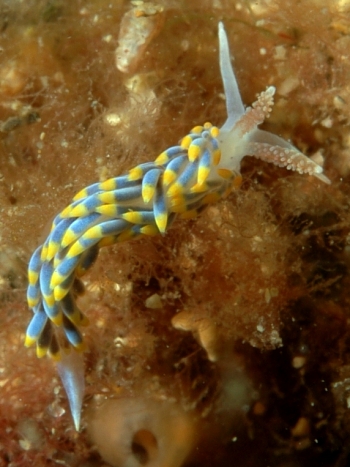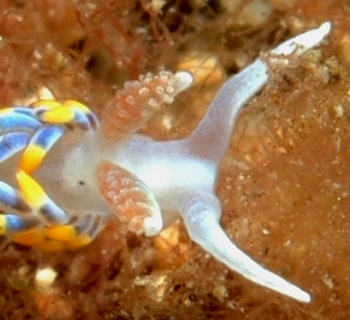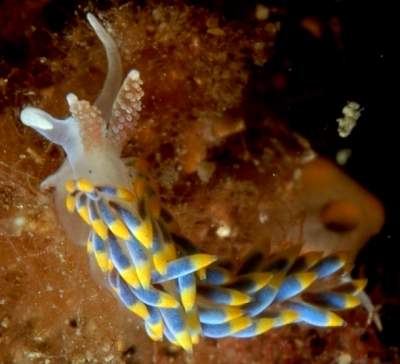Re: Is this a juvenile Berghia coerulescens?
May 2, 2008
From: Miquel Pontes


Concerning message #2450:
Dear Bill,
Besides being a passionate diver and nudibranch photographer, I do also enjoy investigating the ethymology of the nudibranch names.
In one of our last dives (April 19th, 2008) we came across this nice Berghia coerulescens in about 8 meters of water, at Illa Mateua (L'Escala, Costa Brava, Spain). Water temperature was about 13ºC.
Locality: Illa Mateua, 8 m., L'Escala, Costa Brava, Girona, Spain, Mediterranean Sea, 19 April 2008, Rocky bottom covered with photophile algae. Length: 25 mm.. Photographer: Miquel Pontes.
What draw my attention was the fact that this nudibranch's species name is "coerulescens" while a very similar "Cuthona" nudibranch receives the species name "caerulea ".
Being used a Latin word for describing one of the main animal traits (that of blue color in cerata, as "coerulea" means "blue") I found it "funny" that two slugs so close in appearance have a different species name.
Theoretically "coerulea" is the proper Latin word for describing "blue" while "caerulea" is often used, but it is not widely accepted. To my understanding species names should be "Berghia coerulescens" and "Cuthona coerulea ". This is not the case in the Forum nor in the bibliography.
I know, I know, it's just a letter, but in science there should be a reason for every fact, so I'm intrigued by this case.
For those wondering how these strange Latin names are spelled, here it is an interesting link: http://www.saltspring.com/capewest/pron.htm
Best regards,
Miquel
info@marenostrum.org
miquelpontes@gmail.com
Pontes, Miquel, 2008 (May 2) Re: Is this a juvenile Berghia coerulescens?. [Message in] Sea Slug Forum. Australian Museum, Sydney. Available from http://www.seaslugforum.net/find/21557
Dear Miquel,
Thanks for the nice photos which show the rhinophores very clearly.
Concerning the variations in Latinised words I guess we can blame human individuality rather than human failings. These days IT people want to force us into complete conformity so that database searching becomes 'faultless'. I some times miss the days when I could scan down a list and my brain would pick up the variations and mispellings which computers still can't do easily.
Another interesting site is Botanical Epithets which lists lots of plant species names with meanings and the latin root which is useful in changing endings to match gender etc. I have listed below some of the words for blue or deep blue and I am sure there are many more. You can see there that the oe - ae vowel was transcribed in both ways. However in Zoological Nomenclature the spelling used by the original author is the valid spelling except in a few special cases.
caelestinus, caelestini, caelestinum, caelestis, caelestis, caeleste, caelicolor, caelicolores, coelestinus, coelestina, coelestinum, coelestis, coelestis, coeleste, coeruleus, coerulea, coeruleum, caeruleus, caerulea, caeruleum.
The site you mention, on pronunciation, reminds me of many funny occasions I have witnessed at scientific gatherings, where everybody pronounces scientific names with their own unique pronuciations, sometimes developed from school latin, but usually from the way their own language pronounces vowels and consonants. It can be quite confusing for a while. I often get told by amateur helpers that they are embarrassed to use scientific names because their pronunciation is silly. I just tell them that when 10 malacologists meet there will up to 12 different pronunciations for the same name.
Best wishes,
Bill Rudman
Related messages
-
Berghia coerulescens and egg ribbon?
From: Sylvie Grall, October 14, 2008 -
Re: Berghia coerulescens from French Mediterranean
From: Dominique Horst, September 5, 2008 -
Berghia coerulescens from Croatia
From: Duncan v Vliet, October 10, 2003 -
Berghia coerulescens from French Mediterranean
From: Marina Poddubetskaia, August 3, 2003 -
Is this a juvenile Berghia coerulescens?
From: Erwin Koehler, May 26, 2000
